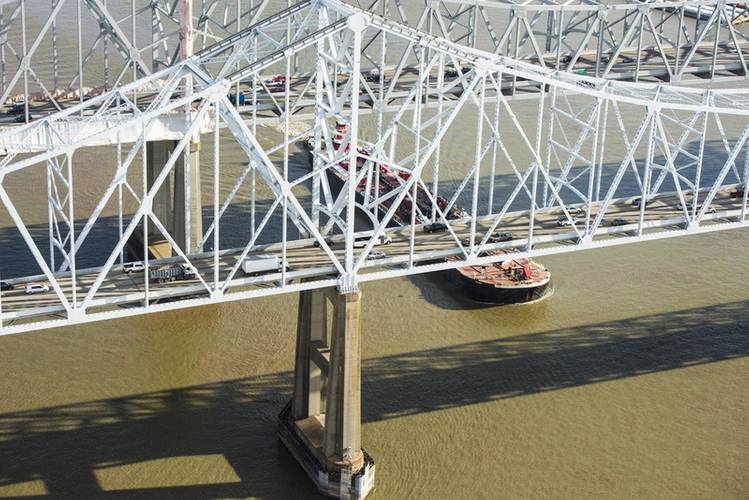Just before the anticipation of good things to come on Valentine’s Day, on February 12, the inland waterways transportation industry was left feeling disappointed and puzzled after the release of the long-awaited Trump Administration infrastructure principles, and then the release of President Trump’s FY 2019 budget request.
During the Presidential campaign, then-candidate Trump said he would undertake a $1 trillion infrastructure initiative that would focus on a wide array of projects, from sewer systems to bridges to Veterans Hospitals to rural broadband expansion.
President Trump visited the Ohio River on June 7, 2017, and talked of the “dilapidated system of locks and dams that are more than half a century old,” and said, ”capital improvements of the system, which [are] so important, have been massively underfunded. And there’s an $8.7 billion maintenance backlog that is only getting bigger and getting worse ... citizens know firsthand that the rivers, like the beautiful Ohio River, carry the life blood of our heartland.” His visit was historic, and was cheered by those committed to the inland waterways transportation system, its carrier, shippers, laborers, manufacturers, energy providers and others, and for the first time in a long time, there was a true spirit of hopefulness.
In his visit to the river, President Trump described how, “Together, we will fix it. We will create the first-class infrastructure our country and our people deserve.” At the State of the Union address at the end of January, where the President mentioned “waterways,” he announced that his Administration would undertake an even larger plan – a $1.5 trillion initiative – to repair America’s infrastructure.
But the optimism felt by the inland waterways carriers and shippers quickly turned to disappointment when the actual infrastructure proposal was released on February 12, as it recommends modernizing the waterways transportation system by authorizing the Federal Government (likely the Corps of Engineers) and “third party service providers” to impose and retain tolls or lockage fees on the lock and dam system. It also recommends eliminating the role of the Federal government to construct, operate and maintain the Nation’s waterways by transferring that responsibility to non-Federal public or private entities. Since the founding of the United States, the Federal government has played a role in operating and maintaining the inland waterways because the system is a national treasure, and does not belong to one state or entity.
The Administration’s infrastructure proposal seems less that “together, we will fix it,” and actually more like commercial operators and shippers are the only ones who will be expected to fix it, and to pay significantly more for the Nation’s waterways transportation system, despite being just one beneficiary of the lock and dam system.”
Currently, commercial waterways operators – just 400 companies across the entire national system – are the only beneficiary to contribute 29-cents-per-gallon diesel fuel tax to a dedicated Inland Waterways Trust Fund, matched by General Treasury Funds, that pays for the costs of construction and major rehabilitation of the system. Other system beneficiaries – recreational boaters, commercial fishermen, and those who benefit from hydropower generation, municipal and industrial water supply, flood control and national security – do not contribute to waterways improvements, although they utilize and rely upon the lock and dam system. In some cases, recreational boaters utilize the locks even more than the commercial sector.
At the end of 2014, through the advocacy of Waterways Council, Inc., (WCI), inland waterways carrier and shipper members successfully advocated for a 45 percent increase to the diesel fuel tax deposited into the Inland Waterways Trust Fund for increased investment to the system. Inland waterways carriers pay the highest tax of any surface transportation mode in the nation.
While WCI is grateful that there is attention being paid to waterways infrastructure, if the Administration’s infrastructure recommendations are adopted, the Inland Waterways Trust Fund would be responsible for operating and maintaining the inland navigation system at an estimated cost that is eight times that of current Trust Fund revenue/income. This is simply unsustainable and would cause a modal shift, drive traffic off the waterways to other modes that are already capacity constrained, and impact our Nation’s competitiveness in world markets.
Issued on the same day as the Administration’s infrastructure principles, the President’s FY2019 budget request to Congress was equally disheartening, as it proposes to cut more than 22 percent of the U.S. Army Corps of Engineers’ Civil Works funding to $4.78 billion, down from the FY2018 Senate Appropriations Committee’s funding level of $6.16 billion.
The FY2019 budget requests a paltry $5.25 million of the $114 million collected in revenues in 2017 from the Inland Waterways Trust Fund with only the Olmsted project to be funded (at $35 million to its completion, expected this year). The budget estimates that the Trust Fund will collect $104 million in FY2019. The balance/surplus in the Inland Waterways Trust Fund is estimated to balloon to $340 million, if this budget were to be accepted. Work at the other three priority navigation projects under construction – Lower Mon in Pennsylvania, Kentucky Lock in Kentucky and Chickamauga Lock in Tennessee – would cease and workers would be laid off if the President’s budget were adopted.
The FY2019 budget also proposes a New User Fee on Inland Waterways. The proposal would establish a vessel user fee to supplement existing revenue from the $0.29 per-gallon diesel fuel tax to help finance the users’ share of anticipated capital investment projects, as well as 10 percent percent of the cost of Operations and Maintenance (O&M) – historically a Federal responsibility – activities on the inland waterways. This proposal would seek to raise approximately $1.7 billion over a 10-year window.
The FY2019 budget proposes $2.07 billion for O&M, a cut from the FY2018 Senate Appropriations Committee funding level of $3.52 billion, with $760 million going toward the inland waterways.
On the harbor maintenance front, the President’s budget request for FY2019 would reduce, by around half-a-billion dollars, the Harbor Maintenance Tax rate, from $1.6 billion collected into the Harbor Maintenance Trust Fund currently to around $1.1 billion “to better align estimated annual receipts from the tax with recent appropriation levels for eligible expenditures from the Harbor Maintenance Trust Fund. Reducing this tax would provide greater flexibility for individual ports to establish appropriate fee structures for services they provide, in order to help finance their capital and operating expenses on their own,” according to the Administration budget documents.
This FY2019 budget request represents a clear disconnect from the encouraging rhetoric made by President Trump about the inland waterways in the State of Union address and at during his historic visit to the Ohio River last June. If accepted, this budget, like the infrastructure proposal issued earlier today, hamstrings America’s ability to compete in the world, and could virtually eliminate the cost-competitive advantage the waterways provide to shippers.
Carriers, and shippers like American family farmers, energy/petroleum and coal producers, cement and construction material companies, and many others who rely on the waterways to ship their products around the U.S. and the globe, would be saddled with massive increases that will deter freight from the waterways. This has the potential to negatively affect our agriculture trade balance, increase traffic congestion on our highways and railways, and impact our environment.
WCI looks forward to working with the Trump Administration and with Congress to develop an equitable and meaningful infrastructure plan, and to see full and efficient funding provided for the U.S. Army Corps of Engineers. Without these, modernization of our critical waterways infrastructure may be just something that was talked about, while our Nation’s competitive advantage in the world gets locked out. We can and must do better.
The Author
Michael J. Toohey is President/CEO, Waterways Council, Inc.
(As published in the March 2018 edition of
Marine News)










